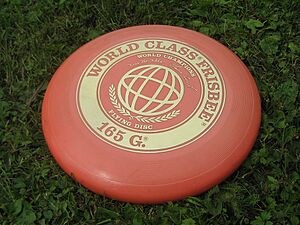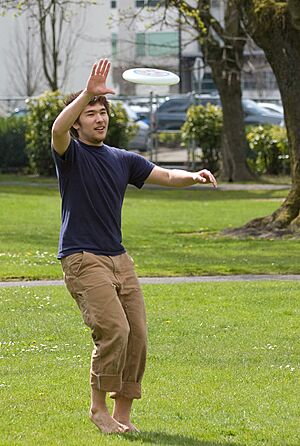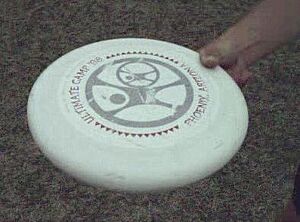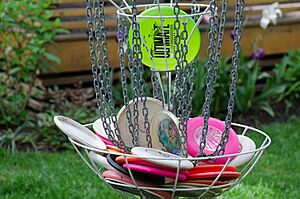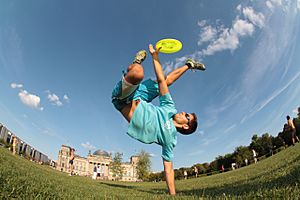Frisbee facts for kids
A frisbee (pronounced FRIZ-bee) is a fun toy or sports item. It's also called a flying disc or just a disc. Most frisbees are made of plastic and are about 20 to 25 centimeters (8 to 10 inches) wide. They have a special shape, like an airplane wing, that helps them fly through the air. When you spin a frisbee, it stays steady and can fly far and straight.
People use flying discs for throwing and catching, both for fun and in sports. There are many types of flying discs. Some are made for disc golf and are smaller and heavier. Others are softer for playing with dogs, so they don't hurt their mouths. Some discs even light up or whistle!
The word frisbee is often used for any flying disc. But Frisbee is actually a special brand name owned by the Wham-O toy company. Because of this, official sports like ultimate or disc golf use the general term "flying disc" instead of "Frisbee."
Contents
History of the Flying Disc
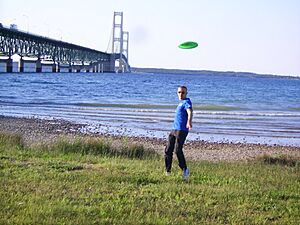
The idea for the flying disc came from Walter Frederick Morrison in the late 1930s. One Thanksgiving Day in 1937, he and his future wife, Lucile, were tossing a popcorn can lid. Later, they found people on a beach in Los Angeles would pay 25 cents for a cake pan they were throwing. This was a lot more than the 5 cents the pan cost! Morrison realized there was a business idea there.
The Morrisons continued their small business until World War II. After the war, Walter Morrison designed a better flying disc. He called it the "Whirlo-Way." By 1948, he and his partner, Warren Franscioni, started making plastic discs. They changed the name to "Flyin-Saucer" because of all the news about unidentified flying objects.
Morrison and Franscioni would show off their discs at fairs. People were so amazed, they thought wires were used to make them fly! So, they joked, "The Flyin' Saucer is free, but the invisible wire is $1.00." People were excited about the discs.
Morrison later designed a new model in 1955 called the "Pluto Platter." This disc became the basis for all modern flying discs. He sold the rights to the Wham-O company in 1957.
In June 1957, Wham-O's founders, Richard Knerr and Arthur "Spud" Melin, learned that college students were calling the Pluto Platter "Frisbee." This name came from the Frisbie Pie Company in Connecticut. Students at Yale University used to throw empty pie tins from this company, which had the company's logo stamped on them. This was similar to how Morrison and his wife started with a cake pan.
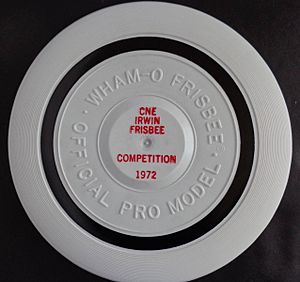
In 1964, Ed Headrick joined Wham-O. He redesigned the Pluto Platter, making the rim thicker and heavier. This made the disc much easier to control and throw accurately.
Wham-O then started promoting the Frisbee as a new sport, and sales grew. Headrick even patented his design, which included special raised ridges called "Rings of Headrick." These ridges were said to help the disc fly steadily.
Ed Headrick became known as the "father of Frisbee sports." He started the International Frisbee Association. He also helped create disc golf, inventing the special targets called "pole holes." When Headrick passed away, some of his ashes were even molded into memorial discs!
In 1998, the Frisbee was added to the National Toy Hall of Fame. Today, flying disc sports are popular around the world.
Variations of Flying Discs
Flying discs come in different types, each made for a specific sport or activity. The three main kinds are ultimate discs, golf discs, and freestyle discs.
Ultimate Discs
Ultimate discs are made for the sport of Ultimate. They are usually made of strong plastic. These discs are designed to be thrown far and accurately.
For official Ultimate games, discs have a standard size. They are about 27 centimeters (10.75 inches) wide and weigh 175 grams (6.2 ounces). This helps make sure games are fair and consistent.
Disc Golf Discs
Disc golf discs are used in the sport of disc golf. They are similar in size to ultimate discs but come in different weights and designs. They are often made from polypropylene plastic.
There are three main types of disc golf discs:
- Drivers: Used for long throws.
- Mid-range discs: For more controlled shots.
- Putters: For short, accurate throws into the target.
Disc golf discs have sharper rims than ultimate discs. This helps them cut through the air better and reduces wind drag. The smallest size for a golf disc is 21 centimeters (8.3 inches) wide.
Freestyle Discs
Freestyle discs are used in freestyle Frisbee competitions. These discs are usually smaller and lighter than other types. Most are about 25.5 centimeters (10 inches) wide and weigh around 160 grams (5.6 ounces). Their size and weight can change based on what the performer needs.
Disc Sports
Before the 1970s, the Frisbee was mostly seen as a toy. But then, several competitions started, showing that it could be a real sport. These early tournaments helped make flying disc sports popular.
Double Disc Court
This sport was created in 1974 by Jim Palmeri. It's played with two flying discs and two teams of two players. Each team tries to land a disc in the other team's court.
Disc Dog
In disc dog sports, people throw flying discs for their dogs. Dogs and their human partners compete in events like catching discs from a distance or performing choreographed routines.
Disc Golf
This is a sport where players throw a flying disc at a target, usually a special "pole hole." The goal is to get the disc into the target in the fewest throws possible. The game was standardized in 1976 by Ed Headrick, who invented the pole holes.
Freestyle Competition
Created in 1974 by Ken Westerfield and Jim Kenner, freestyle competition involves teams of two or three players. They perform creative throwing and catching moves, often set to music. Judges score their routines.
Goaltimate
Goaltimate is a fast-paced disc game similar to ultimate. Players pass the disc to move it down the field. They score points by throwing the disc to a teammate who is in a small scoring area.
Guts
The game of guts was invented by the Healy Brothers in the 1950s. Two teams stand facing each other and throw flying discs at members of the opposing team. Players try to catch the disc without it touching the ground.
KanJam
KanJam is a patented game where teams score points by throwing and deflecting a flying disc to hit or enter a goal. A team wins by scoring exactly 21 points or by getting an instant win by throwing the disc directly into the goal.
Ultimate
Ultimate is the most widely played disc game. It started in the late 1960s. The game's goal is to pass the disc to a teammate in the opposing team's end zone to score points. Players cannot run while holding the disc.
How Flying Discs Fly
Flying discs are designed to fly like special wings. Their shape helps them move through the air easily. This shape creates "lift," which pushes the disc up, and reduces "drag," which pulls it back.
When you throw a disc, you also make it spin. This spin is very important! It makes the disc act like a gyroscope, which helps it stay stable and fly smoothly. Without spin, a disc would wobble and fall quickly. The spin also helps you aim the disc and throw it far.
The way a disc flies depends on how fast it's thrown, its angle, and how much it spins. Even small changes in these things can make a disc fly differently. Scientists and players study these things to understand how to throw discs better for different sports.
See also
 In Spanish: Frisbee para niños
In Spanish: Frisbee para niños
- Aerobie
- AUDL
- Boomerang
- Discus
- Flying ring
- Flying cylinder
- Ultimate Canada
- USA Ultimate


